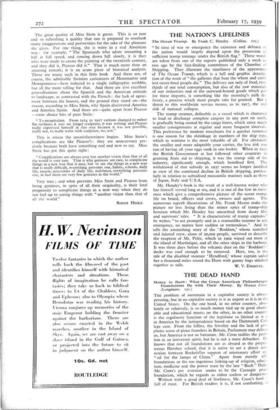THE NATION'S LIFELINES The Ocean Tramp. By Frank C. Hendry.
(Collins. 21s.) " IN time of war or emergency the existence and defence of the nation would largely depend upon the possession of sufficient tramp tonnage under the British flag." These words are taken from one of the reports published only a week or two ago by the fact-finding committees of the Chamber of Shipping. They illustrate the timeliness of the appearance of The Ocean Tramp, which is a full and graphic descrip- tion of the work of " the galleons that bear the wheat and cattle lest street-bred people die." The delivery not only of food, two- thirds of our total consumption, but also of the raw materials of our industries and of the outward-bound goods which pay for these imports, is something like the morning's milk de- livery, a process which most people take for granted. But a threat to this worldwide service means, as in 1917, the real risk of national collapse.
The tramp steamer, definable as a vessel which is chartered to load or discharge complete cargoes in any port on earth, is gradually being ousted by the cargo liners, which carry much smaller consignments at regular and more frequent intervals. This preference by modern merchants for a quicker turnover is one reason for the shrinkage in numbers of the ship type, which in wartime is the most valuable of all. For obviously the smaller and more adaptable your carrier, the less risk you run of having all your eggs sunk in one basket. When in 1935 the British Government at last followed other countries in granting State aid to shipping, it was the tramp side of the industry, significantly enough, which benefited first. The withdrawal of that subsidy in 1937 seems no longer justified in view of the continued decline in British shipping, particu- larly in relation to subsidised mercantile marines such as those of Japan, Italy and U.S.A.
Mr. Hendry's book is the work of a well-known writer who has himself served long at sea, and it is one of the few in exist- ence which give a comprehensive picture of the ocean tramp, life on board, officers and crews, owners and agents. The numerous superb illustrations of Mr. Frank Mason make the picture no less living than the minor epics of tramp-ship heroism which Mr. Hendry has unearthed from dusty files and survivors' tales. " It is characteristic of tramp captains," he writes, " to act promptly and in a seamanlike manner in any emergency, no matter how sudden or tremendous." And he tells the astonishing story of the Roddam,' whose scorched and injured crew, alone of 20,000 people, survived to describe the eruption of Mt. Pelee, which in 1902 wiped out most of the island of Martinique, and all the other ships in the harbour. It was three days before the volcanic dust on the Roddam's ' decks was cool enough to be removed. Here, too, is the tale of the disabled steamer Hyndford,' whose captain sailed her a thousand miles round the Horn with gunny bags stitched










































 Previous page
Previous page